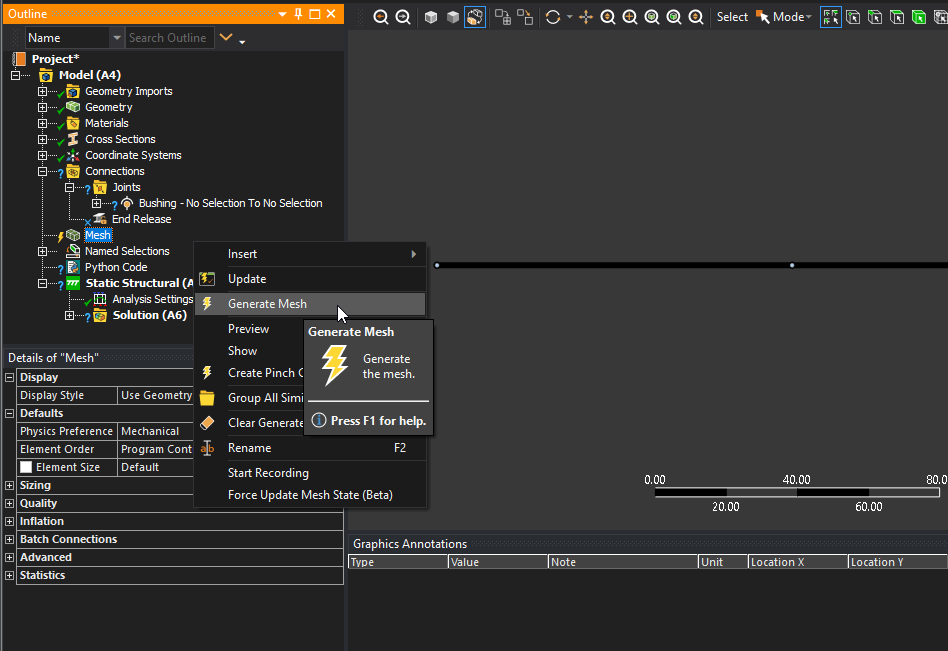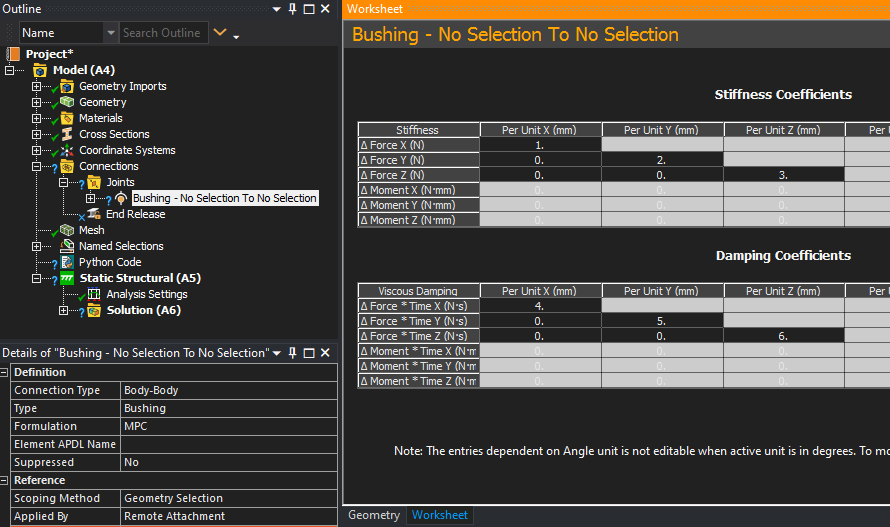Parameterize Bushing Joint.
This example shows how to parameterize Bushing Joint Stiffness and Damping coefficients. Insert a Python Code object under Model in the Tree. Specify Target Callback = After Mesh Generated.
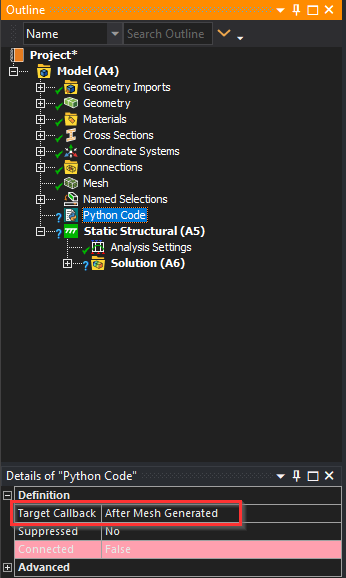
Then, delete all the default code added in Script and copy/paste the following code:
def after_mesh_generated(this,mesh_object):# Do not edit this line
jointValueKX = this.GetCustomPropertyByPath("Joint Selection/Stiffness per unit X").Value
jointValueKY = this.GetCustomPropertyByPath("Joint Selection/Stiffness per unit Y").Value
jointValueKZ = this.GetCustomPropertyByPath("Joint Selection/Stiffness per unit Z").Value
jointValueDX = this.GetCustomPropertyByPath("Joint Selection/Damping per unit X").Value
jointValueDY = this.GetCustomPropertyByPath("Joint Selection/Damping per unit Y").Value
jointValueDZ = this.GetCustomPropertyByPath("Joint Selection/Damping per unit Z").Value
my_joint = this.GetCustomPropertyByPath("Joint Selection/Joint Selection").ValueString
my_joint_Tree = DataModel.GetObjectsByName(my_joint)[0]
joint_tree = my_joint_Tree.BushingWorksheet
joint_tree.SetBushingStiffnessPerUnitX(0,float(jointValueKX))
joint_tree.SetBushingStiffnessPerUnitY(1,float(jointValueKY))
joint_tree.SetBushingStiffnessPerUnitZ(2,float(jointValueKZ))
joint_tree.SetBushingDampingPerUnitX(0,float(jointValueDX))
joint_tree.SetBushingDampingPerUnitY(1,float(jointValueDY))
joint_tree.SetBushingDampingPerUnitZ(2,float(jointValueDZ))

Now, paste the following code under Property Provider:
#PROPERTY PROVIDER
def reload_props():
this.PropertyProvider = None
provider = Provider()
group = provider.AddGroup("Joint Selection")
double_prop = group.AddProperty("Stiffness per unit X", Control.Double)
double_prop.CanParameterize = True
double_prop.ValidRange = (0., 4.0e9)
double_prop2 = group.AddProperty("Stiffness per unit Y", Control.Double)
double_prop2.CanParameterize = True
double_prop2.ValidRange = (0., 4.0e9)
double_prop3 = group.AddProperty("Stiffness per unit Z", Control.Double)
double_prop3.CanParameterize = True
double_prop3.ValidRange = (0., 4.0e9)
double_prop4 = group.AddProperty("Damping per unit X", Control.Double)
double_prop4.CanParameterize = True
double_prop4.ValidRange = (0., 4.0e9)
double_prop5 = group.AddProperty("Damping per unit Y", Control.Double)
double_prop5.CanParameterize = True
double_prop5.ValidRange = (0., 4.0e9)
double_prop6 = group.AddProperty("Damping per unit Z", Control.Double)
double_prop6.CanParameterize = True
double_prop6.ValidRange = (0., 4.0e9)
this.PropertyProvider = provider
options_prop = group.AddProperty("Joint Selection", Control.Options)
my_joints_dict = {}
joints = DataModel.GetObjectsByType(DataModelObjectCategory.Joint)
for index,joint in enumerate(joints): my_joints_dict.Add(index+1,joint.Name)
options_prop.Options = my_joints_dict
this.PropertyProvider = provider
# region Property Provider Template
from Ansys.ACT.Mechanical.AdditionalProperties import PropertyProviderAdapter
from Ansys.ACT.Mechanical.AdditionalProperties import *
from mech_templates import property_templates
property_templates.set_ext_api(ExtAPI)
class Provider(Ansys.ACT.Interfaces.Mechanical.IPropertyProvider):
# region These are callbacks that as a user you may want to modify to get specific behavior
def IsValid(self, prop):
"""
Called when checking the validity of a property, with the property instance.
"""
# for double property use the ValidRange property to check validity
if(isinstance(prop, DoubleProperty)):
return prop.ValidRange[0] <= prop.Value and prop.ValidRange[1] >= prop.Value
return True
def IsReadOnly(self, prop):
"""
Called when checking if a property should be readonly, with the property instance.
"""
return False
def IsVisible(self, prop):
"""
Called when checking if a property should be visible, with the property instance.
"""
return True
def SetValue(self, prop, val):
"""
Allows you to override the setter of the Value property on the property instance.
Keyword Arguments:
prop -- property of which the value is being set
val -- the value that was set
Returns:
The value that the Value property should be set to
"""
return val
def GetValue(self, prop, val):
"""
Allows you to override the getter of the Value property on the property instance.
Keyword Arguments:
prop -- property of which the value is being set
val -- current value of the Value property
Returns:
The value that the getter on the internal value should return
"""
return val
# endregion
# structures that hold property instances
prop_list = []
prop_map = {}
prop_groups = set()
class __AnsGroup():
"""
Helper group class to group properties, and provides methods to add properties to groups.
"""
provider = None
def __init__(self,name=None, provider=None):
self.name = name
self.provider = provider
def __AddScopingProperty(self, name):
"""
Adds a scoping property with a given name to this group.
Keyword Arguments :
name -- unique name for the scoping property
"""
scoping_prop = property_templates.ScopingProperty(name, self.name)
for prop in scoping_prop.GetGroupedProps():
self.provider.AddProperty(prop)
return scoping_prop.GetGroupedProps()
def AddProperty(self, name=None, prop_control=None, module_name=None):
"""
Creates an instance of the property and connects delgates in
the associated Property Propvider.
Keyword Arguments :
name -- unique name for the scoping property
prop_control -- one of the built in controls, or extended controls
module_name -- module where the control is defined
"""
#special case for scoping property
if(prop_control == "Scoping" and module_name == "property_templates"):
return self.__AddScopingProperty(name)
#if no module_name is passed, use the globals in current module
#that has the built in controls imported
prop_mod_globals = None
if(module_name != None):
if(module_name not in globals()):
raise Exception("Unknown module : " + module_name)
prop_mod_globals = globals()[module_name].get_globals()
else:
prop_mod_globals = globals()
#class name is built based on control + "Property"
# Double - > DoubleProperty
prop_class_name = str(prop_control) + "Property"
if(prop_class_name not in prop_mod_globals):
raise Exception("Unknown property class : " + prop_class_name)
#instantiate the property based on module and class name
prop = prop_mod_globals[prop_class_name](self.name + "/" + name, self.name)
if(prop == None):
raise Exception("Issue while creating the property instance.")
#set the delegates to property provider functions
prop.IsValidCallback = self.provider.IsValid
prop.IsReadOnlyCallback = self.provider.IsReadOnly
prop.IsVisibleCallback = self.provider.IsVisible
prop.GetValueCallback = self.provider.GetValue
prop.SetValueCallback = self.provider.SetValue
#as a default make the property name the property display name
prop.DisplayName = name
#add property to the provider
self.provider.AddProperty(prop)
return prop
def __init__(self):
pass
def GetProperties(self):
"""
Returns a list of properties in the order that they were added to the property provider.
"""
return [self.prop_map[propName] for propName in self.prop_list]
def AddGroup(self, name=None):
"""
Creates an instance of helper group class and returns it.
"""
if name in self.prop_groups:
raise Exception("Group with name " + name + " already exists, please use a unique group name.")
#keep groups names so we can make sure no duplicate groups are added
self.prop_groups.add(name)
return self.__AnsGroup(name, self)
def AddProperty(self, prop):
"""
Method used by the helper group class to add the property to the data-structure holding
the property instances.
"""
if(prop.Name in self.prop_map):
raise Exception("Property name must be unique, property with name '" + prop.Name + "' already exisits.")
self.prop_list.append(prop.Name)
self.prop_map[prop.Name] = prop
reload_props()
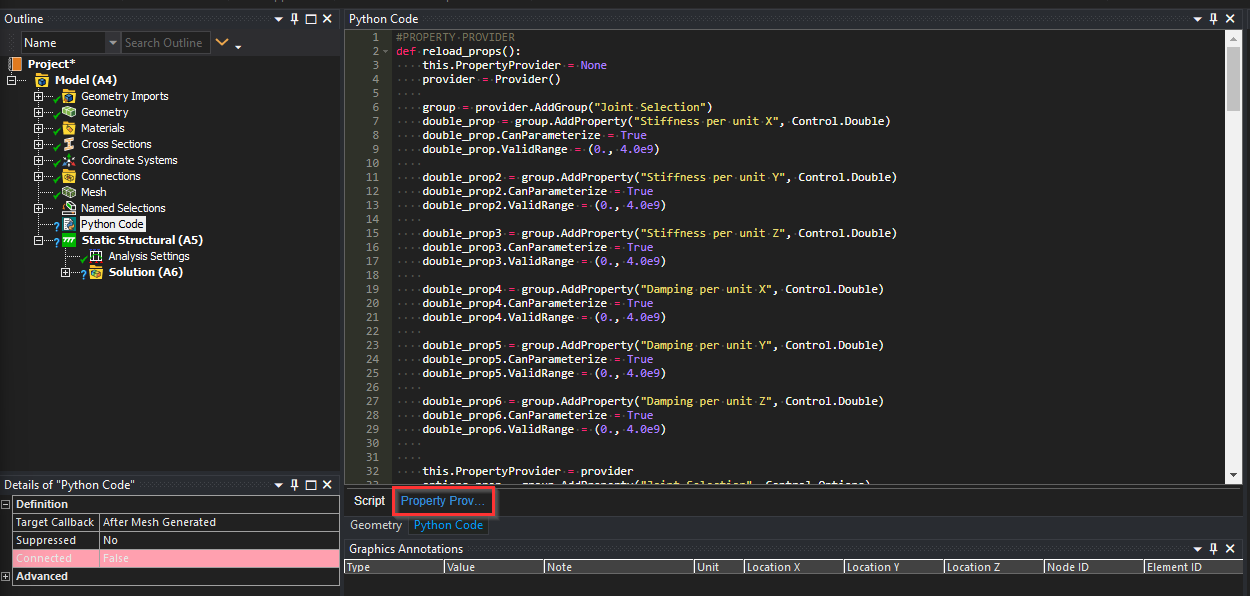
Now, Reload Properties:
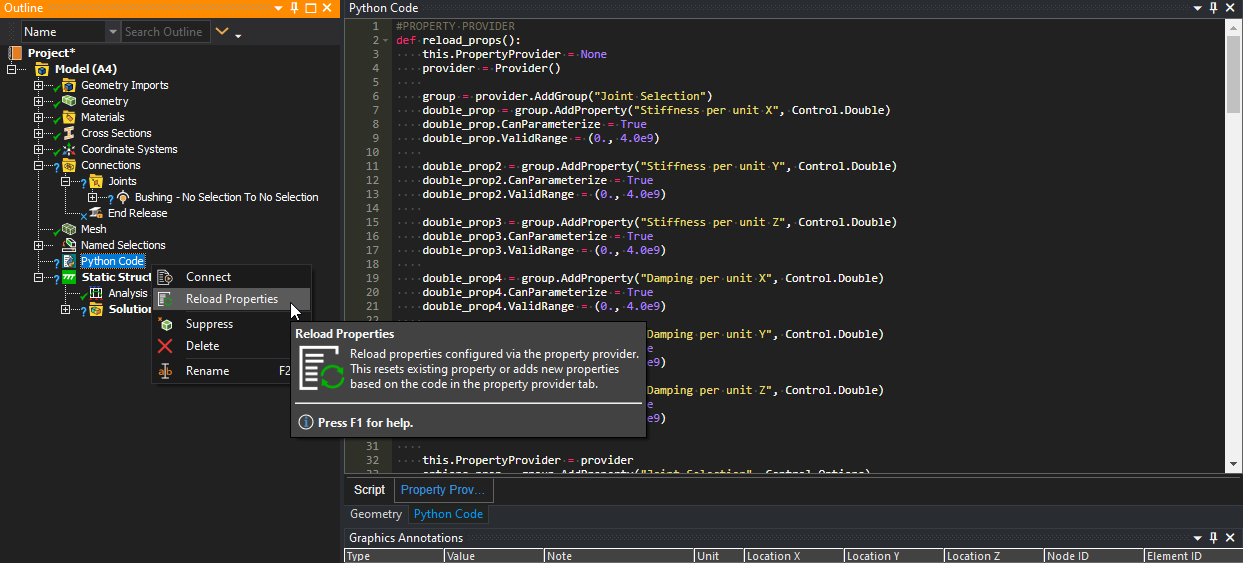
Define the properties, select bushing from the Joint Selection dropdown. Right mouse click on the Python Code object and click Connect.
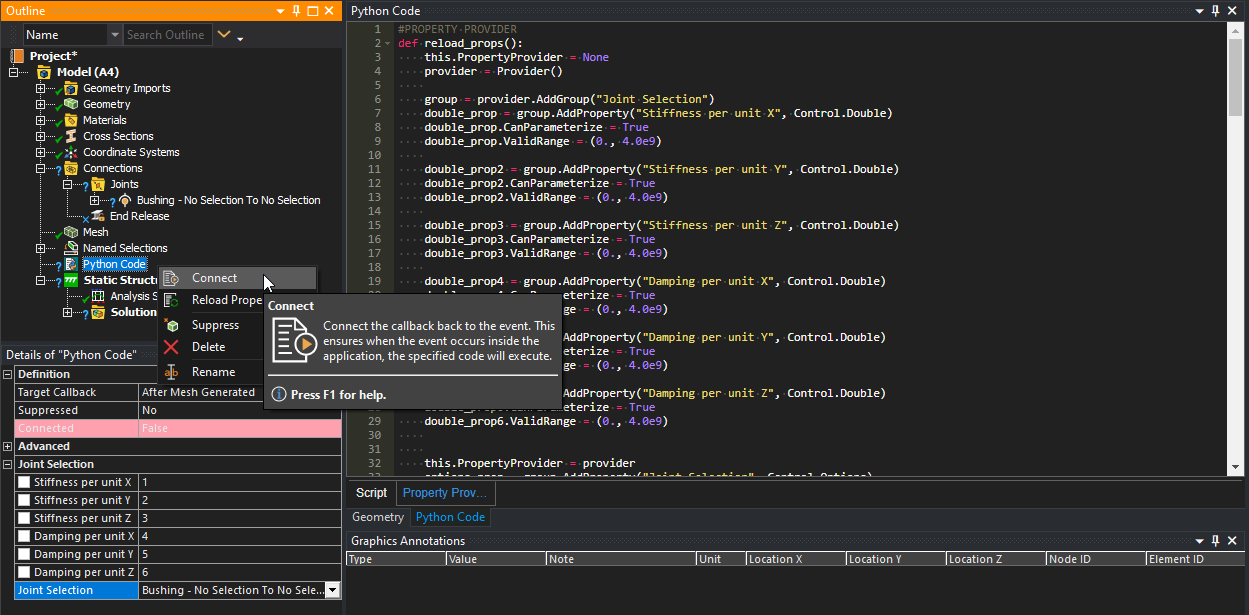
Generate Mesh and check that the stiffness/damping coefficients changed!
